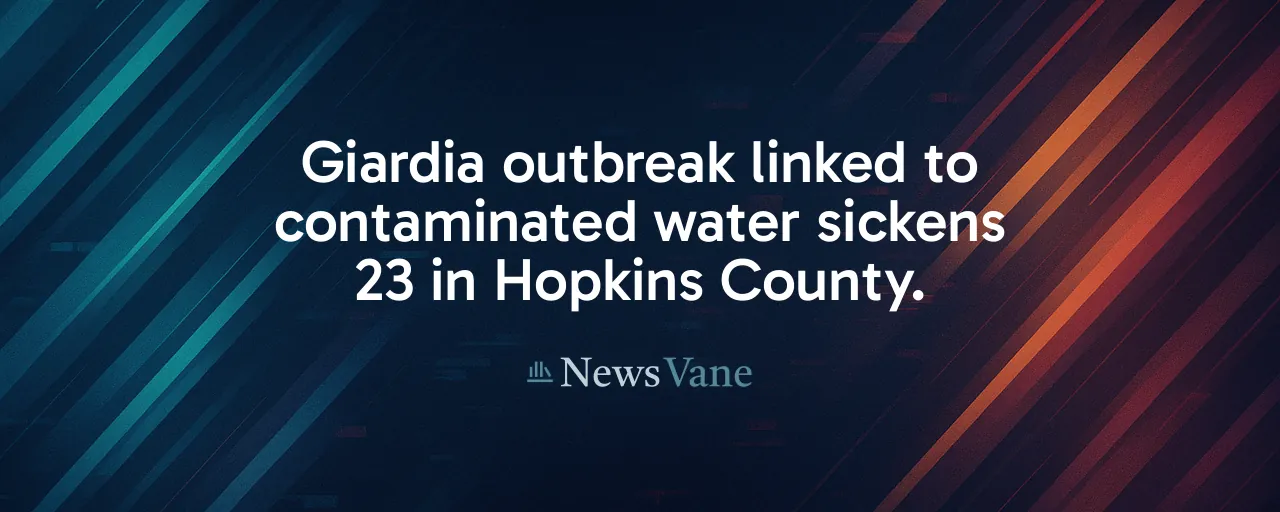A Parasite Stirs Concern in Hopkins County
A quiet summer in Hopkins County, Kentucky, turned urgent in July 2025 when health officials confirmed a Giardia outbreak. At least 23 residents fell ill within a month, grappling with watery diarrhea, cramps, and fatigue. The culprit? A microscopic parasite called Giardia duodenalis, which spreads through contaminated water, food, or surfaces. Local media sounded the alarm, quoting the county health department's call for vigilance as epidemiologists scrambled to trace the source.
The outbreak has jolted the community, raising questions about water safety and public health readiness. While officials investigate potential exposures in lakes, pools, and childcare settings, residents face a pressing reality: preventing further spread requires swift action. The situation underscores a broader challenge: ensuring clean water and robust health systems in small communities.
Understanding Giardia's Stealthy Spread
Giardia thrives in environments where sanitation falters. Swallowed in tiny cysts, the parasite can lurk in untreated water or on unwashed hands, surviving weeks in cold conditions and resisting standard pool chlorine. Symptoms often hit one to two weeks after exposure, though some carriers spread it without feeling sick. Research from the CDC shows that 35 percent of U.S. giardiasis outbreaks between 2012 and 2017 were waterborne, while 26 percent stemmed from person-to-person contact, often in childcare centers or homes.
In Hopkins County, the source remains elusive. Health teams are testing water samples and interviewing patients, focusing on recreational sites and private wells. The outbreak's scale, 23 cases in a month, signals a cluster far above Kentucky's typical 80 to 120 annual cases. For residents, the immediate priority is clear: avoid untreated water and wash hands thoroughly.
The Ripple Effects on Community and Economy
Beyond physical symptoms, the outbreak carries social and economic weight. Parents worry about childcare centers, where person-to-person spread is common. Low-income families, often without access to bottled water, face heightened risks. Businesses like restaurants and pools brace for inspections or closures, which could cost thousands in lost revenue. Medical costs for a single case range from $150 to $500, and widespread illness could strain local hospitals and drive workplace absenteeism.
Community leaders face a delicate balance. Swift health measures protect residents but risk disrupting local commerce. Past outbreaks in Kentucky, often tied to heavy rainfall and runoff into wells, show how quickly trust in water safety can erode. The stakes are high for a county where economic stability hinges on small businesses and tourism.
Lessons From Past Outbreaks
Giardia is no stranger to the U.S. In the 1970s, it emerged as a major waterborne pathogen after outbreaks tied to poorly filtered municipal systems. Kentucky's history reflects similar patterns, with clusters often following storms that contaminate private wells. Nationwide, improved surveillance since 2011 has sharpened case tracking, revealing persistent spread in childcare settings. These lessons shape today's response in Hopkins County, where officials prioritize rapid testing and public education.
Research underscores the long-term risks. Chronic Giardia infections in children can lead to stunting and cognitive delays, particularly in low-income areas. While most cases resolve with treatment, the disease's ability to linger undetected demands proactive measures. Historical data guide the current strategy: break transmission through hygiene, testing, and targeted interventions.
Balancing Action With Practicality
Health officials advocate a multi-pronged approach. Hand-washing campaigns, backed by the CDC, remain a cornerstone of prevention, alongside advice to boil or avoid suspect water. At-home stool tests can speed diagnosis, but clear instructions are vital. For businesses, voluntary inspections offer a first step, with closures reserved for confirmed risks. These measures aim to curb spread without overburdening local employers or sparking panic.
Water testing poses another challenge. Private wells, common in rural Kentucky, often escape routine checks. Subsidizing tests for low-income households could close this gap, while multilingual alerts ensure all residents stay informed. The goal is precision: targeted action based on evidence, tailored to avoid straining resources or unfairly hitting businesses.
A Path to Resilience
The Hopkins County outbreak reveals gaps in water safety and public health but also points to solutions. Community-wide hygiene efforts, paired with timely testing, can halt Giardia's spread. Investments in local health departments, from lab upgrades to more inspectors, could strengthen future responses. Temporary sick-leave support for service workers might prevent workplace transmission, easing economic pressures.
Residents and leaders alike have a role. Simple steps, washing hands, boiling water, reporting symptoms, build a collective defense. The outbreak serves as a reminder: clean water and health vigilance are shared responsibilities, vital to a community's strength.
As Hopkins County navigates this crisis, the response could set a model. By blending education, targeted testing, and economic sensitivity, the county can emerge safer and more prepared. The parasite may have caught the community off guard, but the resolve to protect public health burns strong.
